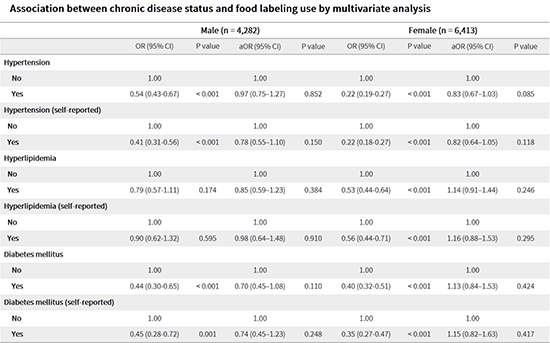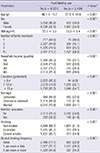1. Korea Centers for Disease Control and Prevention. The fourth korea national health and nutrition examination survey (KNHANES IV-3). accessed on 1 August 2012. Available at
https://knhanes.cdc.go.kr/.
2. World Health Organization. Preventing chronic diseases: a vital investment. Geneva: World Health Organization;2005.
3. Sacks FM, Svetkey LP, Vollmer WM, Appel LJ, Bray GA, Harsha D, Obarzanek E, Conlin PR, Miller ER 3rd, Simons-Morton DG, et al. DASH-Sodium Collaborative Research Group. Effects on blood pressure of reduced dietary sodium and the Dietary Approaches to Stop Hypertension (DASH) diet. N Engl J Med. 2001; 344:3–10.
4. Esmaillzadeh A, Kimiagar M, Mehrabi Y, Azadbakht L, Hu FB, Willett WC. Fruit and vegetable intakes, C-reactive protein, and the metabolic syndrome. Am J Clin Nutr. 2006; 84:1489–1497.
5. Setayeshgar S, Whiting SJ, Vatanparast H. Prevalence of 10-year risk of cardiovascular diseases and associated risks in canadian adults: the contribution of cardiometabolic risk assessment introduction. Int J Hypertens. 2013; 2013:276564.
6. Taylor J. 2013 ESH/ESC guidelines for the management of arterial hypertension. Eur Heart J. 2013; 34:2108–2109.
7. Evert AB, Boucher JL, Cypress M, Dunbar SA, Franz MJ, Mayer-Davis EJ, Neumiller JJ, Nwankwo R, Verdi CL, Urbanski P, et al. Nutrition therapy recommendations for the management of adults with diabetes. Diabetes Care. 2013; 36:3821–3842.
8. Hawkes C. World Health Organization. Nutrition labels and health claims: the global regulatory environment. Geneva: World Health Organization;2004.
10. Taylor CL, Wilkening VL. How the nutrition food label was developed, part 1: the Nutrition Facts panel. J Am Diet Assoc. 2008; 108:437–442.
12. Zarkin GA, Dean N, Mauskopf JA, Williams R. Potential health benefits of nutrition label changes. Am J Public Health. 1993; 83:717–724.
14. Post RE, Mainous AG 3rd, Diaz VA, Matheson EM, Everett CJ. Use of the nutrition facts label in chronic disease management: results from the National Health and Nutrition Examination Survey. J Am Diet Assoc. 2010; 110:628–632.
15. Kang HT, Shim JY, Lee YJ, Linton JA, Park BJ, Lee HR. Reading nutrition labels is associated with a lower risk of metabolic syndrome in Korean adults: the 2007-2008 Korean NHANES. Nutr Metab Cardiovasc Dis. 2013; 23:876–882.
16. Lewis JE, Arheart KL, LeBlanc WG, Fleming LE, Lee DJ, Davila EP, Cabán-Martinez AJ, Dietz NA, McCollister KE, Bandiera FC, et al. Food label use and awareness of nutritional information and recommendations among persons with chronic disease. Am J Clin Nutr. 2009; 90:1351–1357.
17. Kessler H, Wunderlich SM. Relationship between use of food labels and nutrition knowledge of people with diabetes. Diabetes Educ. 1999; 25:549–559.
18. Fitzgerald N, Damio G, Segura-Pérez S, Pérez-Escamilla R. Nutrition knowledge, food label use, and food intake patterns among Latinas with and without type 2 diabetes. J Am Diet Assoc. 2008; 108:960–967.
19. Lee KA, Lee HJ, Park EJ. The effect of use of nutrition labelling on knowledge and perception of nutrition labelling, and awareness of nutrition labelling usefulness with among college students. J Korean Soc Food Sci Nutr. 2010; 39:253–266.
20. Kwon KI, Yoon SW, Kim SJ, Kang H, Kim HN, Kim JY, Kim SY, Kim K, Lee JH, Jung SM. A survey on customers' perceptions of nutrition labeling for processed food and restaurant meal. Korean J Nutr. 2010; 43:181–188.
21. Kim SY, Lee JH. Effect of nutrition labeling use on consumers' food choices. J Consum Stud. 2010; 21:107–128.
22. Chen X, Jahns L, Gittelsohn J, Wang Y. Who is missing the message? Targeting strategies to increase food label use among US adults. Public Health Nutr. 2012; 15:760–772.
23. De la Cruz-Góngora V, Villalpando S, Rodríguez-Oliveros G, Castillo-García M, Mundo-Rosas V, Meneses-Navarro S. Use and understanding of the nutrition information panel of pre-packaged foods in a sample of Mexican consumers. Salud Publica Mex. 2012; 54:158–166.
24. Sharf M, Sela R, Zentner G, Shoob H, Shai I, Stein-Zamir C. Figuring out food labels. Young adults' understanding of nutritional information presented on food labels is inadequate. Appetite. 2012; 58:531–534.
25. Roberto CA, Larsen PD, Agnew H, Baik J, Brownell KD. Evaluating the impact of menu labeling on food choices and intake. Am J Public Health. 2010; 100:312–318.
26. Ollberding NJ, Wolf RL, Contento I. Food label use and its relation to dietary intake among US adults. J Am Diet Assoc. 2010; 110:1233–1237.
27. Graham DJ, Laska MN. Nutrition label use partially mediates the relationship between attitude toward healthy eating and overall dietary quality among college students. J Acad Nutr Diet. 2012; 112:414–418.







 PDF
PDF ePub
ePub Citation
Citation Print
Print





 XML Download
XML Download